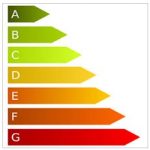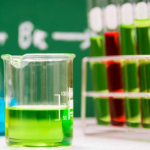We use cookies to personalize content and advertisements, to offer social media functions and to analyze access to our website.
You can revoke the given consent at any time. You can find further information in our Privacy Policy.
Apr 2017
On 21, Apr 2017 | In News @en | By Alisa Maier
 The European Parliament and the Council agreed recently on a revised energy label within the EU Energy Labelling Directive 2010/30/EU. The current A+++ to G labels for energy-related products will be replaced by a scale from A to G.
With the revised label, consumer shall be able to make their purchase decision easier as the distinction between the different classes is clearer to perceive. Products showing the revised label are expected to be available in shops at the earliest at the end of 2019.
Any future rescaling should be triggered when 30% of products sold on the EU market fall into the top energy efficiency class A, or when 50% of these products fall into the top two energy efficiency classes A and B.
Furthermore, the revised Energy Labelling Directive will introduce a product registration database to support market surveillance activities by the Member States. The database will provide a public area containing all energy efficiency labels, which allows consumers to compare the energy efficiency performance of products.
The revision of the Energy Labelling Directive 2010/30/EU has to be formally adopted by the European Parliament and the Council, and will then be officially published in the EU Official Journal.
The European Parliament and the Council agreed recently on a revised energy label within the EU Energy Labelling Directive 2010/30/EU. The current A+++ to G labels for energy-related products will be replaced by a scale from A to G.
With the revised label, consumer shall be able to make their purchase decision easier as the distinction between the different classes is clearer to perceive. Products showing the revised label are expected to be available in shops at the earliest at the end of 2019.
Any future rescaling should be triggered when 30% of products sold on the EU market fall into the top energy efficiency class A, or when 50% of these products fall into the top two energy efficiency classes A and B.
Furthermore, the revised Energy Labelling Directive will introduce a product registration database to support market surveillance activities by the Member States. The database will provide a public area containing all energy efficiency labels, which allows consumers to compare the energy efficiency performance of products.
The revision of the Energy Labelling Directive 2010/30/EU has to be formally adopted by the European Parliament and the Council, and will then be officially published in the EU Official Journal.
Apr 2017
On 03, Apr 2017 | In Events | By Alisa Maier
Mar 2017
On 20, Mar 2017 | In Conflict Minerals, News @en | By Alisa Maier
 Members of EU Parliament approved on March 16, 2017 a draft EU regulation on Conflict Minerals: Importers of tin, tungsten, tantalum and gold are obliged to do due diligence checks on their suppliers.
Tin, tungsten, tantalum and gold are used in the production of many high-tech devices, in the automotive, electronics, aerospace, packaging, construction, lighting, industrial machinery and tooling industries, as well as in jewellery.
Importers have to do their due diligence checks in accordance with the respective OECD guidelines. However, also big EU firms (with over 500 employees) will be encouraged to report on their sourcing practices and will be able to join an EU registry.
Once the Council has approved the new regulation, it will be published in the EU Official Journal. The new due diligence obligations will apply from January 1, 2021.
www.europarl.europa.eu/news/en/news-room/20170308IPR65672/conflict-minerals-meps-secure-due-diligence-obligations-for-importers
Members of EU Parliament approved on March 16, 2017 a draft EU regulation on Conflict Minerals: Importers of tin, tungsten, tantalum and gold are obliged to do due diligence checks on their suppliers.
Tin, tungsten, tantalum and gold are used in the production of many high-tech devices, in the automotive, electronics, aerospace, packaging, construction, lighting, industrial machinery and tooling industries, as well as in jewellery.
Importers have to do their due diligence checks in accordance with the respective OECD guidelines. However, also big EU firms (with over 500 employees) will be encouraged to report on their sourcing practices and will be able to join an EU registry.
Once the Council has approved the new regulation, it will be published in the EU Official Journal. The new due diligence obligations will apply from January 1, 2021.
www.europarl.europa.eu/news/en/news-room/20170308IPR65672/conflict-minerals-meps-secure-due-diligence-obligations-for-importers
Jan 2017
 On January 12, 2017 the European Chemicals Agency (ECHA) published the new Candidate List, adding four new substances. The Candidate List now contains 173 substances of very high concern (SVHC).
The four new entries refer to:
4,4′-isopropylidenediphenol (bisphenol A, BPA) (EC 201-245-8), which was added to the list due to its toxic for reproduction properties. Bisphenol A is used in manufacturing of polycarbonate, epoxy resins, chemicals and as a hardener in epoxy resins.
Nonadecafluorodecanoic acid (PFDA) and its sodium and ammonium salts (EC 206-400-3 (sodium salt), EC 221-470-5 (ammonium salt)), which were added to the list due to their toxic for reproduction and persistent, bioaccumulative and toxic (PBT) properties. PDFA is used as plasticiser, lubricant, wetting agent and corrosion inhibitor.
p-(1,1-dimethylpropyl) phenol (EC 201-280-9), which was included to the list due to equivalent level of concern, having probable serious effects to environment. Substance is used in manufacturing of chemicals and plastic products.
4-heptylphenol, branched and linear, which was included to the list due to equivalent level of concern, having probable serious effects to environment. This substance is used in manufacturing of polymers and formulation into lubricants.
More information on https://echa.europa.eu/-/four-new-substances-of-very-high-concern-added-to-the-candidate-list
On January 12, 2017 the European Chemicals Agency (ECHA) published the new Candidate List, adding four new substances. The Candidate List now contains 173 substances of very high concern (SVHC).
The four new entries refer to:
4,4′-isopropylidenediphenol (bisphenol A, BPA) (EC 201-245-8), which was added to the list due to its toxic for reproduction properties. Bisphenol A is used in manufacturing of polycarbonate, epoxy resins, chemicals and as a hardener in epoxy resins.
Nonadecafluorodecanoic acid (PFDA) and its sodium and ammonium salts (EC 206-400-3 (sodium salt), EC 221-470-5 (ammonium salt)), which were added to the list due to their toxic for reproduction and persistent, bioaccumulative and toxic (PBT) properties. PDFA is used as plasticiser, lubricant, wetting agent and corrosion inhibitor.
p-(1,1-dimethylpropyl) phenol (EC 201-280-9), which was included to the list due to equivalent level of concern, having probable serious effects to environment. Substance is used in manufacturing of chemicals and plastic products.
4-heptylphenol, branched and linear, which was included to the list due to equivalent level of concern, having probable serious effects to environment. This substance is used in manufacturing of polymers and formulation into lubricants.
More information on https://echa.europa.eu/-/four-new-substances-of-very-high-concern-added-to-the-candidate-list
Jan 2017
Jan 2017
On 09, Jan 2017 | In Events | By Alisa Maier
Jan 2017
 On December 19, 2016, the Member States Committee of the European Chemicals Agency (ECHA) has unanimously agreed on the identification of the following four substances of very high concern (SVHC):
4,4′-isopropylidenediphenol (bisphenol A) (EC 201-245-8), identified due to its toxic for reproduction properties. Bisphenol A is used in manufacturing of other substances, epoxy resins, coating materials, thermal paper and as antioxidant for processing of PVC.
Nonadecafluorodecanoic acid (PFDA) and its sodium and ammonium salts (EC 206-400-3), identified due to their toxic for reproduction and persistent, bioaccumulative and toxic (PBT) properties. PDFA is used as plasticiser, lubricant, surfactant, wetting agent and corrosion inhibitor.
4-heptylphenol, branched and linear (4-HPbl), identified due to its endocrine-disrupting properties for the environment. Polymers derived from 4-heptylphenol are used in lubricant activities for vehicles or machinery.
4-tert-pentylphenol (PTAP) (EC 201-280-9), identified due to its endocrine-disrupting properties for the environment. PTAP is used as an intermediate in the production of perfumes and fragrances and in the industrial formulation of adhesives, coatings, and paints.
ECHA will include the four new SVHCs to the REACH Candidate List in January 2017. Following the amendment, the Candidate List will contain 173 substances.
More information on https://echa.europa.eu/-/member-state-committee-issues-four-svhc-agreements-and-two-opinions
On December 19, 2016, the Member States Committee of the European Chemicals Agency (ECHA) has unanimously agreed on the identification of the following four substances of very high concern (SVHC):
4,4′-isopropylidenediphenol (bisphenol A) (EC 201-245-8), identified due to its toxic for reproduction properties. Bisphenol A is used in manufacturing of other substances, epoxy resins, coating materials, thermal paper and as antioxidant for processing of PVC.
Nonadecafluorodecanoic acid (PFDA) and its sodium and ammonium salts (EC 206-400-3), identified due to their toxic for reproduction and persistent, bioaccumulative and toxic (PBT) properties. PDFA is used as plasticiser, lubricant, surfactant, wetting agent and corrosion inhibitor.
4-heptylphenol, branched and linear (4-HPbl), identified due to its endocrine-disrupting properties for the environment. Polymers derived from 4-heptylphenol are used in lubricant activities for vehicles or machinery.
4-tert-pentylphenol (PTAP) (EC 201-280-9), identified due to its endocrine-disrupting properties for the environment. PTAP is used as an intermediate in the production of perfumes and fragrances and in the industrial formulation of adhesives, coatings, and paints.
ECHA will include the four new SVHCs to the REACH Candidate List in January 2017. Following the amendment, the Candidate List will contain 173 substances.
More information on https://echa.europa.eu/-/member-state-committee-issues-four-svhc-agreements-and-two-opinions
Dec 2016
On 16, Dec 2016 | In News @en | By Alisa Maier
Dec 2016
On 05, Dec 2016 | In Copyright Levies, News @en | By Alisa Maier
 Already one year ago, on October 1, 2015, Austria’s Copyright Act Amendment 2015 entered into force. The major amendment was the introduction of copyright levies on digital storage. Five month later, in March 2016, collecting societies and industry associations finally agreed on tariffs for storage media and devices newly in scope ranging from as little as EUR 0.35 for memory cards up to EUR 5.00 for computers. These tariffs are applicable retroactively from October 1, 2015.
However, there are claims for levies on these products for considerably longer retroactive periods. Therefore negotiations had to be continued for the period up to September 30, 2015. It took negotiating partners another 2 months to find an agreement for periods between 2012 and 2015. Although the rates are quite similar (there is no tariff for memory cards, digital picture frames and smart watches), they are applied retroactively for devices sold as of January 1, 2013, January 1, 2012 for mobile phones respectively.
Moreover, Austrian collecting society Austro-Mechana (AUME) has published a list of “compliant” companies. This so called whitelist is in line with paragraph 1.6 of the contract between collecting societies and industry. Contractors on this list have registered, reported and paid copyright levies in time.
For more information regarding the general agreement, the framework contract or the list of compliant companies, please contact us at contact@1cc-consulting.com.
Already one year ago, on October 1, 2015, Austria’s Copyright Act Amendment 2015 entered into force. The major amendment was the introduction of copyright levies on digital storage. Five month later, in March 2016, collecting societies and industry associations finally agreed on tariffs for storage media and devices newly in scope ranging from as little as EUR 0.35 for memory cards up to EUR 5.00 for computers. These tariffs are applicable retroactively from October 1, 2015.
However, there are claims for levies on these products for considerably longer retroactive periods. Therefore negotiations had to be continued for the period up to September 30, 2015. It took negotiating partners another 2 months to find an agreement for periods between 2012 and 2015. Although the rates are quite similar (there is no tariff for memory cards, digital picture frames and smart watches), they are applied retroactively for devices sold as of January 1, 2013, January 1, 2012 for mobile phones respectively.
Moreover, Austrian collecting society Austro-Mechana (AUME) has published a list of “compliant” companies. This so called whitelist is in line with paragraph 1.6 of the contract between collecting societies and industry. Contractors on this list have registered, reported and paid copyright levies in time.
For more information regarding the general agreement, the framework contract or the list of compliant companies, please contact us at contact@1cc-consulting.com.
Nov 2016